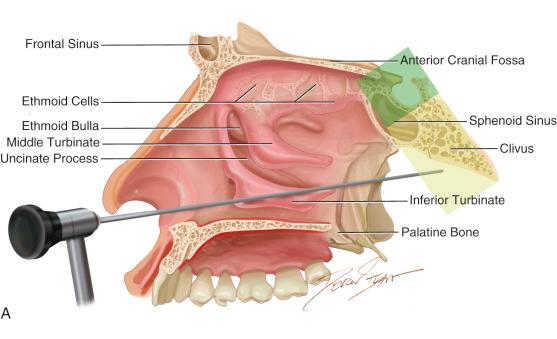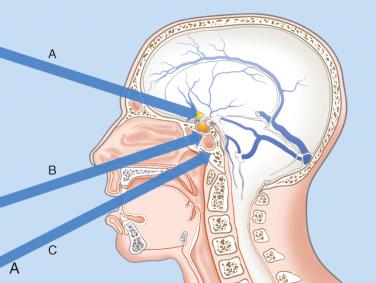Physical Address
304 North Cardinal St.
Dorchester Center, MA 02124
Chordomas are locally aggressive neoplasms that arise from embryonic remnants of the notochord along the vertebral axis. They represent less than 1% of all intracranial neoplasms. They can be divided in three groups according to their location:
Cranial (30–35%)
Sacrococcygeal (50%)
Vertebral (15%).
Symptom presentation depends on the location of the tumor and its relationship to adjacent structures. Compression of cranial nerves in the posterior fossa and obstructive hydrocephalus secondary to a clivus chordoma may lead to headaches, diplopia, neck pain, facial numbness, deafness, tinnitus and vertigo and in some cases severe motor and sensory deficits.
Preoperative work-up includes:
Neuroimaging (MRI and CT scan): useful for evaluation of the location of the tumor and its relation to the clivus, sella, brainstem, optic chiasm, cavernous sinus, internal carotid artery, basilar and vertebral arteries, abducens nerve, axis, atlas, ear canal and petrous bone.
If an endonasal approach is planned, evaluation and facial CT scan for analysis of the nasal cavity and sinus anatomy are suggested.
Treatment modalities include conservative treatment, surgery and radiotherapy.
Surgery is considered in cases presenting with:
Progressive enlargement of the lesion, and/or
Development of neurological signs and/or intracranial hypertension.
High-dose radiotherapy is usually recommended as an adjuvant treatment. Proton beam therapy is thought to be superior to other radiation techniques because it can deliver higher radiation to the tumor while sparing surrounding neural structures. described actuarial 5-year local control after proton beam radiation in up to 79%, whereas stereotactic radiosurgery and conventional radiotherapy present the same control rate in 56% and 36%, respectively.
Transcranial and endoscopic endonasal approaches are useful for resection of lesions affecting the skull base and cervical spine.
The endoscopic endonasal approach (EEA) is specially useful in the following cases ( Figure 26.1 ):
Small and medium-size lesions located at the midline, without invasion of neurovascular structures.
Lesions without extension below C2.
Lesions in the skull base that are in the anteromedial compartment, and do not cross the lower cranial nerves (VII–XII).
Clival lesions without involvement of the brainstem or hypoglossal canal.
If the surgical goal is decompression without total resection.

Transcranial approaches (depending on the region targeted: subfrontal, transbasal, extended frontal, subtemporal–infratemporal, transpetrosal and lateral transcondylar) are recommended in the following cases ( Figure 26.2 ):
Lesions extending below C2.
Lesions with the epicenter in the posterolateral compartment of the posterior fossa with or without invasion of the anteromedial compartment.
Lesions with encasement of cavernous sinus cranial nerves (III, IV, V1, V2 and VI).
Lesions extending lateral to the petrous ICA.

The main goal of surgery in skull base chordomas is obtaining gross total resection of the tumor while avoiding postoperative neurologic deficit. In order to preserve quality of life, partial resection may be considered in those lesions adherent to the cranial nerves and/or internal carotid/vertebrobasilar branches. In those cases, follow up with MRI scans and adjuvant radiotherapy may be considered.
New technologies including image guidance, cranial nerve monitoring (especially cranial nerves VI, III and the lower cranial nerves), micro-doppler to identify the course of major vessels, and intraoperative MRI to verify extent of resection are commonly used to maximize rate of resection while preserving function.
The use of lumbar drains or shunts is tailored to each case and is not used routinely.
The patient is positioned supine with the torso elevated 15–20°. The head is fixed in a 3-point headholder and flexed 15–20° for best trajectory to the clivus, planum sphenoidale, tuberculum sella and sphenoidal sinus. Additionally, the head is rotated 5–10° towards the surgeon to increase ergonomics. The hip and knee joints are gently flexed for patient comfort and a soft pillow is placed underneath the knee joints.
Ophthalmic eye ointment is placed on the cornea and conjunctiva, and the eyelids are taped closed to prevent corneal abrasions.
The oropharynx is packed with a 2-inch gauze roll to prevent the accumulation of blood at the perilaryngeal area during surgery, which may cause aspiration at the time of extubation.
The perinasal skin and nasal cavity are prepared with use of povidone iodine. A third-generation cephalosporin can be administered prophylactically.
The nasal cavity is packed for approximately 2 minutes with cottonoids soaked with epinephrine and saline to reduce bleeding related to manipulation of the nasal mucosa.
The entire face, nasal cavity and abdominal wall are sterile prepped and draped. When fat graft is required to fill the tumor resection cavity, a customized graft of abdominal fat tissue is obtained through a 1–2-cm infraumbilical transverse skin incision. Fascia lata can also be obtained from the lateral aspect of the non-dominant lower extremity.
The endoscopic endonasal transsphenoidal procedure can be conceptualized as a series of four steps:
Nasal phase
Drilling the sphenoid and clivus
Tumor removal
Reconstruction.
Become a Clinical Tree membership for Full access and enjoy Unlimited articles
If you are a member. Log in here